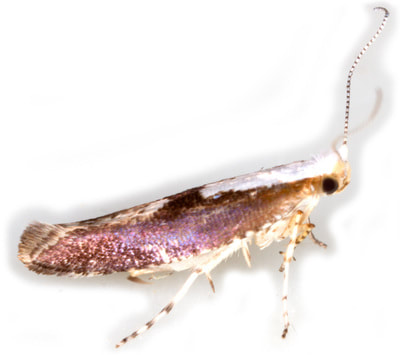Suborder:Glossata Infraorder:Heteroneura Superfamily:Yponomeutoidea
Considered as Subfamily: Argyresthiinae of Family Yponomeutidae in MBGBI3
Argyresthia (24S)
Head down resting posture; Head with vertex rough, frons smooth, Ocelli absent. Proboscis developed, unscaled
Antenna 3/5 - 4/5 length of forewing; smooth to serrate; slightly or moderately pubescent; scape with pecten
Labial palp moderate, somewhat curved, porrect or obliquely ascending, smooth or somewhat rough ventrally; S3=/>S2; S3 pointed
Maxillary palps 1-segmented, minute
Forewing lanceolate, with 12 veins (or 11 if V4&3 coincident); Hindwing narrower than forewing, lanceolate or linear-lanceolate, with 8 veins
Small Y- or V- shaped plate on abdominal S8 in male (I need to determine exactly where this is as MBGBI3 is confusing and gives apparently conflicting information. In the key to subfamilies it does not specify; the introduction to Argyresthiinae states "loosely attached to the 8th abdominal sternite" and in the description of genus Argyresthia "on the dorsal side" of abdominal segment 8).
Male genitalia: uncus poorly developed; socius expanded to form a large lobe; valva simple; saccus absent; aedeagus longer than valva, cornuti present. MBGBI3 also mentions "distinct pseudovalva as in Yponomeutinae" but does not illustrate this in its genital drawings of Argyresthia and does not even mention it in its descriptions of Yponomeutinae. Coremata usually present
Female genitalia: antrum defined, membranous, funnel-shaped; ductus bursae long, membranous; corpus bursae with signum with 1 or 2 strong processes
Considered as Subfamily: Argyresthiinae of Family Yponomeutidae in MBGBI3
Argyresthia (24S)
Head down resting posture; Head with vertex rough, frons smooth, Ocelli absent. Proboscis developed, unscaled
Antenna 3/5 - 4/5 length of forewing; smooth to serrate; slightly or moderately pubescent; scape with pecten
Labial palp moderate, somewhat curved, porrect or obliquely ascending, smooth or somewhat rough ventrally; S3=/>S2; S3 pointed
Maxillary palps 1-segmented, minute
Forewing lanceolate, with 12 veins (or 11 if V4&3 coincident); Hindwing narrower than forewing, lanceolate or linear-lanceolate, with 8 veins
Small Y- or V- shaped plate on abdominal S8 in male (I need to determine exactly where this is as MBGBI3 is confusing and gives apparently conflicting information. In the key to subfamilies it does not specify; the introduction to Argyresthiinae states "loosely attached to the 8th abdominal sternite" and in the description of genus Argyresthia "on the dorsal side" of abdominal segment 8).
Male genitalia: uncus poorly developed; socius expanded to form a large lobe; valva simple; saccus absent; aedeagus longer than valva, cornuti present. MBGBI3 also mentions "distinct pseudovalva as in Yponomeutinae" but does not illustrate this in its genital drawings of Argyresthia and does not even mention it in its descriptions of Yponomeutinae. Coremata usually present
Female genitalia: antrum defined, membranous, funnel-shaped; ductus bursae long, membranous; corpus bursae with signum with 1 or 2 strong processes
Subgenus: Blastotere - forewing V7&8 stalked
|
001 Argyresthia laevigatella
(Larch Tip Moth) |
002 Argyresthia glabratella
(Spruce Tip Moth) ws: 8-11mm; May-Jun; Norway spruce (Picea abies); NS-B in coniferous woodland throughout GB |
003 Argyresthia praecocella
(Juniper Berry Moth) ws: 9-10mm; May; juniper (Juniperus communis); RDB in downland in S.England, woodland in N.Scotland |
|
004 Argyresthia arceuthina
(White-headed Tip Moth) ws: 8-9mm; Apr-Jun; juniper (Juniperus communis); NS-B but common where juniper occurs throughout GB |
005 Argyresthia trifasciata
(Triple-barred Tip Moth) |
006 Argyresthia dilectella
(Juniper Tip Moth) ws: 7-9mm; Jul-Aug; juniper (Juniperus communis) and ornamental conifers; NS-B in downland and open woodland throughout much of GB, less common further north. |
Subgenus: Argyresthia - forewing V7&8 separate
|
013 Argyresthia pygmaeella
(Sallow Tip Moth) |
014 Argyresthia sorbiella
(Rowan Tip Moth) ws: 11-13mm; Jun-Jul; rowan/whitebeam (Sorbus aucuparia/aria); local in open woodland throughout GB |
015 Argyresthia curvella
(Brindled Apple Tip Moth) ws: 10-12mm; Jun-Jul; apple (Malus spp); fairly common in England, Wales, S&C Scotland |
















